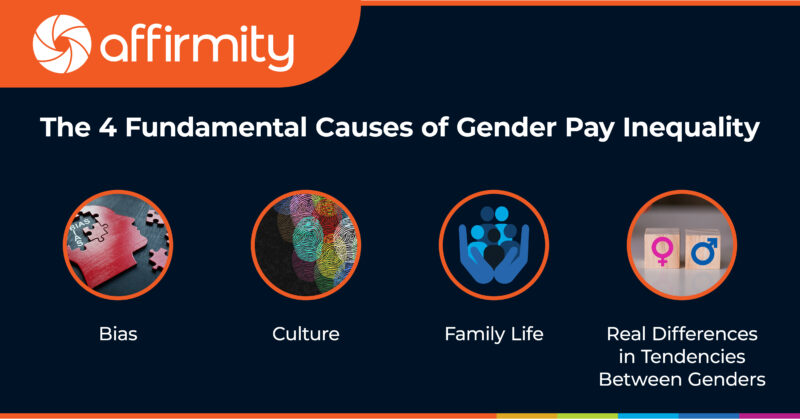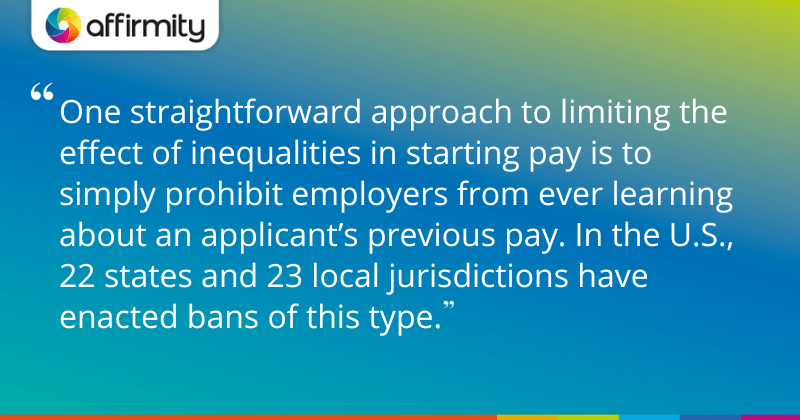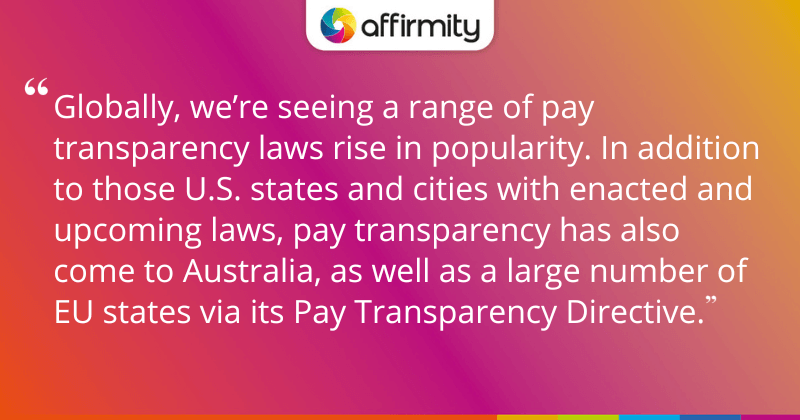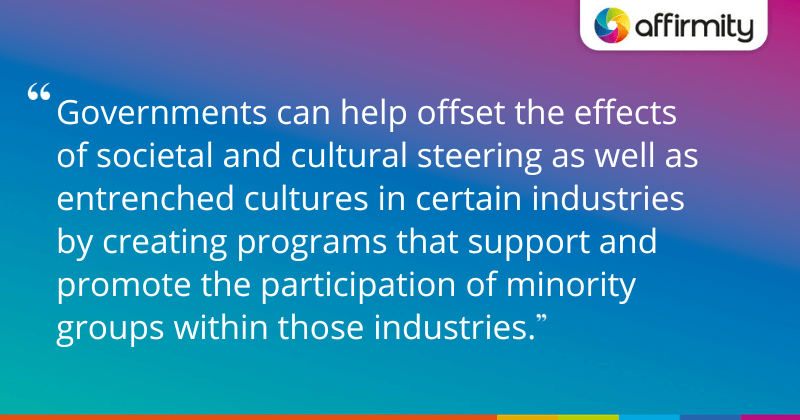As the international community evolves its approach to addressing the various forms of pay inequality, we’ve seen a range of different legal strategies employed—from compulsory pay equity audits, to prohibitions and career support. In this article, we map these strategies to the main causes of pay inequality, discussing specific measures in use in certain parts of the world, and the imbalances in how each cause is addressed.
Overview
In our recent article, The 4 Fundamental Causes of Gender Pay Inequality, we named the four principal causes as:

The article looked in-depth at each of these causes of inequality, and some of the research that has been done to establish the extent of these causes. In this follow-up article, we’ll look instead at the connection between these causes and the different strategies governments are using to reduce the pay gap.
Looking at the scope of each strategy, one of the first things you’ll note is that they overwhelmingly address bias and culture. There are fewer measures currently directly addressing the pay inequalities caused by family life (e.g. the pay cuts associated with taking time out of work to have children), and gender differences (e.g. tendencies observed for traits such as agreeableness, risk assessment, and a preference for meaningful work).
MORE FROM THE BLOG | ‘Lessons From 40 Years of Preparing Leadership for Affirmative Action: Q&A With Veteran Practitioner Ed Johnson’

Prohibitions
Scope: Bias, Culture, Family Life, and Gender Differences
Prohibitions are currently the most versatile of the legal strategies, deployed in various forms to address all four of the underlying causes of gender pay inequality.
- Prohibitions on gender discrimination: Many governments broadly prohibit discrimination based on gender, among other characteristics. This is one of the few measures that address family life-based inequalities, as employers could be forbidden from discriminating against women because of family status, motherhood, or the use of maternity leave and other required parental benefits.
- Equal pay for equal work requirements: These are laws that require males and females to be compensated equitably for doing work that is essentially the same. These laws typically address bias-related inequalities in starting pay and performance-related pay.
- Equal pay for work of equal value requirements: This describes laws that instead concentrate on compensating different types of work at the same rate when their intrinsic value is the same, according to a rubric that considers factors such as requirements, effort, working conditions, and responsibility. These measures typically address culture-based inequalities, though they can also offset the process by which meaningful work is devalued (i.e. more people are attracted to the work, so labor becomes cheaper).
- Anti-harassment policies: Legal strategies addressing harassment help to counterbalance cultural inequalities. Industries or societies can have a history of singling out minority participants for negative treatment, and anti-harassment policies help safeguard those who enter fields dominated by other groups—potentially growing participation in the long term.
- Bans on the use of salary history: One straightforward approach to limiting the effect of inequalities in starting pay is to simply prohibit employers from ever learning about an applicant’s previous pay. In the U.S., 22 states and 23 local jurisdictions have enacted bans of this type.
Carrots and Sticks
Scope: Bias
Another family of legal strategies involves striking a balance between rewarding equitable conditions and punishing non-equitable conditions. This primarily mitigates biases affecting starting pay, promotional increases, and leadership likelihood. Examples of these measures include, penalties for failing minimum equity standards, tax breaks for businesses that work toward pay equity, as well as public reporting of pay gaps (which can be punishing or rewarding depending on how good the numbers look).
Here are some examples. The Brazilian government requires companies with 100 or more employees to publish a salary transparency report on their website twice a year. France requires companies to calculate an equity index and levies heavy fines on companies that repeatedly get below a cutoff score. Italy offers tax exemptions to companies that achieve a gender equality certificate. And, the EU has a directive requiring penalties if less than 40% of a company’s board and less than 33% of a company’s directorships are female (underrepresented sex).

Pay Equity Audits
Scope: Bias and Culture
Auditing addresses pay inequalities that result from starting pay, performance-related pay, and prevailing industry or societal cultural factors. Laws requiring businesses to periodically generate reports containing average or median wages by gender and job classification, and then submit this data to government agencies or for public consumption are on the rise globally. Ten members of the Organisation for Economic Co-operation and Development (OECD) combine gender pay gap reporting with equal pay auditing: Canada, Finland, France, Iceland, Ireland, Norway, Portugal, Spain, Sweden, and Switzerland.
Additional measures include self-auditing activity, certification, and the creation of pay equity plans. Governments may also offer safe harbor provisions in an effort to encourage auditing (this means employers who proactively perform pay equity audits receive legal protections from wage discrimination claims for a limited period).
RECENT REPORTING INFORMATION FOR FEDERAL CONTRACTORS | ‘Pay Equity Reporting FAQs: Answers to 10 of Your Questions After OFCCP Scheduling Letter Updates’
Parental Support
Scope: Bias, Culture, and Family Life
Legal strategies focused on supporting parents are the main way in which governments address family life-based inequalities. Measures can include financial and assistive support for mothers, legal protections for pregnant individuals, paid maternity and parental leave, and subsidized childcare. For example, the European Union requires that all employees (regardless of gender) are entitled to at least four months of parental leave each, of which at least two months must be paid. It also requires a minimum of 14 weeks maternity leave, and two weeks of paternity leave.
Pay Transparency
Scope: Bias and Culture
Globally, we’re seeing a range of pay transparency laws rise in popularity. Some of these laws require job postings (both internal and external) to clearly state pay ranges, others a focused on banning pay secrecy clauses. In addition to those U.S. states and cities with enacted and upcoming laws, pay transparency has also come to Australia, as well as a large number of EU states via its Pay Transparency Directive.
SEE OUR PAY TRANSPARENCY INFOGRAPHIC | ‘Your Visual Guide to State-Level Pay Transparency Laws [September 2024]’
Gender Balancing Goals and Requirements
Scope: Bias and Culture
This is the set of legal strategies to which affirmative action belongs. Other measures can include gender quotas for leadership roles and company board membership. Legislatures may also take steps toward promoting gender balance for various jobs and levels in the organization. The distinction between goals and requirements (i.e. quotas) is an important one, as a goals-based approach such as affirmative action attempts to avoid preferential treatment for any group while still offsetting the underlying inequalities caused by bias and culture. In contrast, quotas such as those found in the EU directive on improving gender balance may actually require discrimination to meet.

Career Support and Career Promotion
Scope: Bias, Culture, and Gender Differences
Governments can help offset the effects of societal and cultural steering as well as entrenched cultures in certain industries by creating programs that support and promote the participation of minority groups within those industries. A familiar example would be the worldwide push for Women in Science, Technology, Engineering, and Mathematics (STEM)—with governments working with a range of nonprofits that aim to create greater participation in these historically male-dominated fields.
In Conclusion
The legal strategies above provide a look at how different governments are tackling the pay inequality problem worldwide. International organizations may have to negotiate different requirements across many countries to remain compliant, and trends in different parts of the world may suggest methods we may soon see close to home. The limited range of strategies addressing inequalities across family life and gender differences may also gesture toward work yet to be done for a fully robust response to pay inequality.
To talk to an expert about how we can support your pay equity efforts, please contact us today.
About the Author
 Patrick McNiel, PhD, is a principal business consultant for Affirmity. Dr. McNiel advises clients on issues related to workforce measurement and statistical analysis, diversity and inclusion, OFCCP and EEOC compliance, and pay equity. Dr. McNiel has over ten years of experience as a generalist in the field of Industrial and Organizational Psychology and has focused on employee selection and assessment for most of his career. He received his PhD in I-O Psychology from the Georgia Institute of Technology. Connect with him on LinkedIn.
Patrick McNiel, PhD, is a principal business consultant for Affirmity. Dr. McNiel advises clients on issues related to workforce measurement and statistical analysis, diversity and inclusion, OFCCP and EEOC compliance, and pay equity. Dr. McNiel has over ten years of experience as a generalist in the field of Industrial and Organizational Psychology and has focused on employee selection and assessment for most of his career. He received his PhD in I-O Psychology from the Georgia Institute of Technology. Connect with him on LinkedIn.
